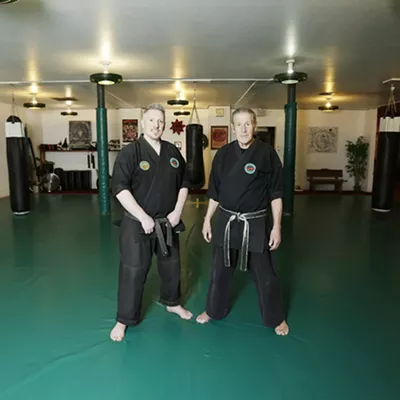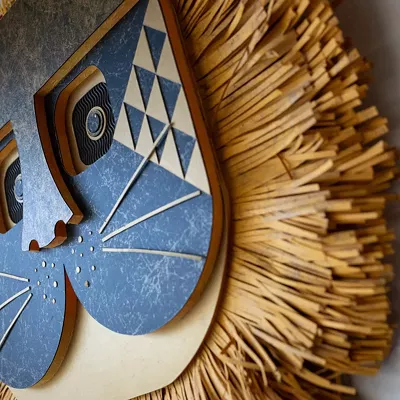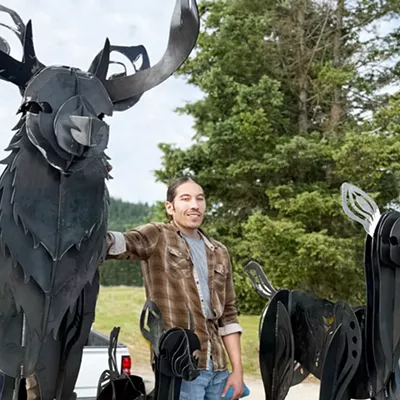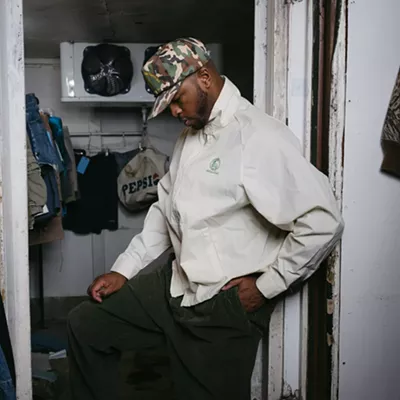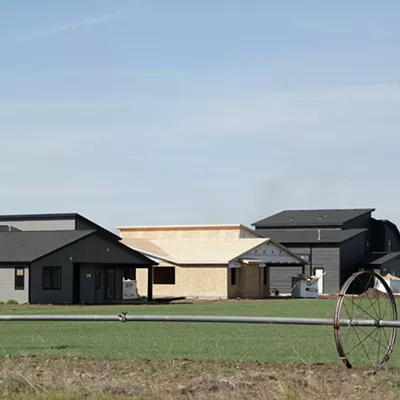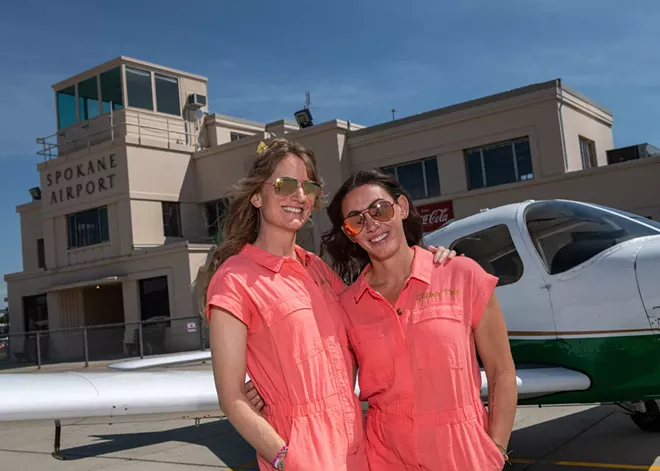
"Fuel is good."
"Master switch coming on."
"Brakes are held."
"Avionics are on."
"Can we request 22 Right for 39 Whiskey?" the pilot asks into the radio.
The four-seater plane — a Piper Cherokee 235 nicknamed "Balvenie" after a Scotch whisky — taxis slowly toward the right-hand runway at Felts Field airport in northeast Spokane.
"Cross 22 Left, 39 Whiskey," she radios to the tower, which gives her the go-ahead to cross the other runway as soon as it's clear.
"We're clear both ways," her co-pilot says through the headphones.
"Primer is in and locked. Controls are free. Door is latched."
The pilot takes a last look around, then glances back at the two passengers huddled in the back seat — a reporter and a photographer whose nerves are starting to spiral about as fast as the plane's single propeller. Its tight revolutions are blurred by the bright windshield and create a halo effect around the pilot's head.
"Our main priorities are safety, and have fun," she says as she throttles up. "If we aren't having one of those things, what are we doing?"
AVIATRIX, ASSEMBLE
Depending on when you're reading this, it's possible that Rachel Skirvin and Sarah Roark are in the air right now.
The two pilots, who took us journalists up in their tiny aircraft this spring, are competing from June 17 to 20 in the Air Race Classic, an all-female transcontinental air race with nearly 100-year-old roots.
The first Women's Air Derby from Santa Monica, California, to Cleveland was in 1929 and featured 20 competitors, including Amelia Earhart. After a few transformations over the years, the 2,400-mile race is still the premier event for female pilots, now featuring over 40 teams and pilots whose ages range from 17 to 90-plus.
Both Skirvin, 39, and Roark, 41, left previous jobs to become pilots as second careers, which is pretty unusual and impressive in the aviation world. Now, the rookies are vying to win the legendary race as the Felts Field Sky Queens, with the call names Glitter Trix and Jet Pink, respectively.
Their team name nods to their home base as well as a unique privilege this year. The Air Race Classic is always different, but this summer, the race begins in Fairhope, Alabama, and ends at Spokane's very own Felts Field. That means the Sky Queens get to cross the finish line at home. But the Inland Northwest is such a hot spot for aviation that three other local teams get to race back home, too: the Lilac Ladies, the Idaho Skies, and the All Sports Aviation Ladies.
A lucky lottery pick means the Sky Queens get to be the first plane to take off from Fairhope. It's an advantage in some ways — like possibly being first in line at any of the nine fuel stops along the way.
But since teams are flying different planes with different amounts of power, it's not pure speed that determines the winner of the race. Each plane receives a certain "handicap," or a judge's determination of a perfect race time for each team's specific plane. The pilots then race against that goal time, not the time of the other competitors, and each team is judged against their own perfect race.
The Sky Queens' Cherokee 235 has about a third more horsepower than the All Sports Aviation Ladies' Cessna Skyhawk 172, for example, but not as much horsepower as, say, the Piper Cherokee 260 that another team is flying. The planes will take off just minutes apart, but all their target finish times will be different, so it's possible a plane that lands second or third or sixth could still win the whole thing.
Still, the Sky Queens have set themselves the extra goal of being the first plane to cross the finish line no matter what. Though the cross country race is scheduled to last four days, the Sky Queens hope to make it back to Spokane in just two.
Mostly because that would just be really cool.
Regardless, all the pilots have to remain at Felts Field for two days after the race concludes while planes are inspected and results are calculated. That means nearly 100 pilots will be hanging around Felts Field Neighbor Day on June 21, a free public event celebrating aviation in the Inland Northwest and around the country.
There will be meet and greets with the racers, helicopter rides, historical exhibits and snacks from food trucks — it'll have pretty much everything to convince a young aviator that, as Roark says, "this is the best job in the world."
GLITTER TRIX
Skirvin is the pilot in command for the Sky Queens. She's the mastermind behind the cute beaded bracelets that she and Roark made to hand out to fans, a determined supporter of teen mom and LGBTQ+ communities (both sparked by personal experience), and presumably among the top 1% of listeners to Pink Pony Club.
Skirvin spent the first 10 years of her professional life as a business manager for HealthCare Resource Group, helping hospital systems navigate complex data and financial systems. She became intimately familiar with the financial strains of rural hospitals and the lifesaving services they provide.
Then came 2020 and the chaos of the COVID pandemic, when Skirvin realized in a new way how short life can be. During lockdown restrictions, Skirvin, her wife, and her three teenagers were all stuck at home, and Skirvin felt a renewed responsibility to lead by example.
"I thought, 'I don't want to sit behind a desk my whole life,'" she says. "I wanted to show the kids that even mom can change careers."
The opposite of sitting at a desk, Skirvin thought, was flying. She decided to see if piloting was really as exciting as she imagined it to be, so she took a discovery flight.
"As soon as we took off, I was hooked," she says.
Skirvin started taking ground school at night but didn't tell any of her colleagues. Any pilot will tell you how intense flight training is, but Skirvin somehow managed to secretly study while also working full time and raising a family. The planes made the schedule worth it.
"Once you're in the air, it's like nothing in the world matters," she says.
There was just one nagging problem that was waiting for her every time she landed. What am I actually going to do with this? she kept asking herself.
It wasn't until she learned about Life Flight Network — a fleet of medical evacuation aircraft that provides intensive medical care and transport from remote areas to hospitals throughout the Northwest — that the stars aligned. She could combine her passion for health care with her love for aviation in a way that could save people's lives — and also inspire plenty of young pilots along the way.
Skirvin needs 2,500 hours flying as a pilot in command before she can apply to fly for Life Flight. To get her hours in, Skirvin became a certified flight instructor. Skirvin's teaching mastery comes from hours of struggling as a student, and her current instructional role is already a powerful testament to perseverance and service.
"I struggled learning the concepts of aviation," Skirvin readily admits — the acronyms, the technical terms, the endless regulations from the Federal Aviation Administration.
"I came up with lots of tricks," she says, "and I hope now to help other students who struggle the same way I did."
JET PINK
Roark, on the other hand, seems like she may have been avoiding becoming a pilot for most of her life.
"Everyone in my family is a pilot," she says.
Roark is the type of person who thinks backcountry flying in bad weather is fun, and whose love for skiing has nearly qualified her for the Winter Olympics.
But she became a librarian instead — or, technically, an archivist, and then a records analyst for a helicopter company. But in 2018, she got back into a Cessna 172 Skyhawk, and "it was like a time machine," she says.
By 2019, Roark was writing technical publications for Alaska Airlines, but her bosses strongly suggested she look into the company's pilot development program.
She considered it, and finally decided that it was time. Roark stopped everything else and got all her certifications — instrument, commercial, multi-engine and seaplane — in nine months. (When Roark mentions this, Skirvin widens her eyes, shakes her head and exhales loudly. That's absolutely insane, she clarifies.)
Now, Roark is flying a private French jet for a local millionaire, taking him wherever he needs to be — Palm Beach, Jackson Hole, San Francisco, you name it. She's completed 1,400 hours of the 1,500 needed to fly commercial jets for Alaska Airlines. It's possible she'll complete her final hours by the end of the air race and be a jet pilot by the end of the month.
Amid all this, Roark found a letter she wrote to herself as an elementary school student. Her preadolescent self predicted she would become a librarian or a pilot.
"I think, for my own sanity, I needed to do this," Roark says.
GIRL POWER
Up until the end of 2024, Skirkin and Roark had never met. It was Andy Luebke, president of Spokane's Washington Pilots Association chapter, who thought that Felts Field should have its own pilot team when he found out that the local airport would host the end of the 2025 Air Race Classic.
He immediately wondered if Skirkin and Roark, "two of the most passionate people about aviation that I've ever met," would be up for it.
"I have no idea what that means, but sure!" Skirkin says she responded when Luebke first approached her with the idea.
As 2024 ended, Roark was closing one of the hardest years of her life, after breaking up with a longtime partner and diving headfirst into a stressful career. A new professional partnership and fast deepening friendship with Skirvin, plus a borderline-insane goal, brought her out of the dark — even though "no one told me how hard this was gonna be," she says.
The Air Race Classic is a grueling test of physical and mental stamina, precision strategy, and expert adaptability. It's all about knowing when to push yourself versus knowing when sheer exhaustion will cost you timely navigation mistakes.
Luebke describes a propeller plane as a "fishbowl in the sky" — basically, an undulating glass prism of bright light, suffocating heat and not a lot of oxygen. One of the pilots' main struggles is fighting dehydration without requiring too many bathroom breaks.
At about 5,500 feet in the air, the small plane is easily swayed by the swirling wind and air currents. Skirvin describes wise piloting as a dance — finding the path of least resistance through the air instead of stubbornly fighting the elements.
"If I lead her in the right direction, she's gonna follow," she says. "It alleviates pressure that I might face with the controls."
All things considered, our ride on a clear May afternoon was pretty smooth — the weather was perfect, and it was never too bumpy to get some chicken scratch notes onto paper. The Cherokee 235 is a fabulous plane. Local banker C.J. Amestoy surprised the Sky Queens by loaning his personal plane for the race, just because he thought it would be more comfortable than the smaller plane Skirvin and Roark assumed they'd use.
"Balvenie" has nice cushioned seats, plenty of horsepower, and a sleek green and white paint job. As far as small aircraft go, it's definitely luxurious enough to earn its high caliber nickname. But there's no autopilot and definitely no air conditioning — just plenty of windows, which let in lots of sunshine.
The bright rays are enough to get you sweating in under half an hour. No wonder the pilots will be wearing triathlon-esque race suits during the actual race.
In addition to practicing in the new plane, the Sky Queens have participated in exhaustion studies at Washington State University and survival courses at the Mike Monroney Aeronautical Center in Oklahoma. Skirvin and Roark wanted to experience disorientation in a controlled environment before potentially dealing with it in the sky.
"When you're exhausted, your body is trying to lie to you," Skirvin says.
For example, your mind will tell you that you're not going straight when your instruments say you're right on track. Trust your instruments, not yourself, Roark says, and get oxygen if you need it.
"When you lack oxygen, your brain is the first thing to go," Roark says.
In addition to canisters of O2, the Sky Queens are packing other necessities — baggies of salt and packets of Squatch Juice, a local energy drink company that, much to Skirvin and Roark's delight, decided to sponsor the team alongside other organizations like Aviate Medical and Women in Aviation.
But most importantly, the pilots will have each other. It's each queen's job to check if the other is OK. Starting off a long preflight checklist is the most important question:
"Number one, are we good?" Skirkin says. "We don't ever have to fly."
Then she turns to Roark.
"I got your back no matter what."
The team is so prepared, they even have a plan for what to do when mistakes inevitably happen.
"You get 90 seconds to sit with a mistake," Skirvin says. "Then, move on."
We're flying at about 130 mph during our flight around Lake Coeur d'Alene. During the race, the pilots will be about three times as high and flying about 30 mph faster.
But at this 5,500-foot elevation, it's pretty easy to identify landmarks below. Roark points out the popular hiking spot Rocks of Sharon under our wing, its giant boulders suddenly like pebbles below us.
Even though Skirvin and Roark have seen this view countless times, they still ooh and ahh over the scenery below.
"Isn't this beautiful?" Skirvin asks through the headsets. "We live in such a beautiful area."
At one point, we can see Hauser, Newman and Liberty Lake all at the same time.
"This is a lot of what we'll be doing — enjoying the view, checking our power, trying to remember to listen to the radio," Skirvin continues. "Oh, and streaming music through the radio so we can both listen to the same thing."
Roark taps an iPad that's connected to the plane's avionics system and pulls up Spotify.
"Wanna recommend any songs?" she says.
"Felts Sky Queens: Glitter Trix and Jet Pink Jams" is a public playlist with 200 of the boppiest, jammiest, girl-power-fueled bangers for 11 hours of sky-high hopes. Crafted by the Sky Queens and their fans, it's got everything unapologetic and uplifting: Shania Twain, Ke$ha, Taylor Swift, Destiny's Child, Rihanna, Cardi B, and, obviously, Chappell Roan. There's plenty of "angry girl music," too, Skirvin says, for when the going gets especially tough.
Anyone on the ground can listen to or suggest additions to the playlist while the pilots are in the sky. Crank up the volume and send good, speedy vibes to Skirvin and Roark when you hear lines like "Starships were meant to fly / Hands up and touch the sky," "It was such a roller coaster / Some killer queen you are," or "Who run the world? / Girls."
EQUITY, ERASURE, EXCLUSION
"A world where the sky is open to all. Where aviation and aerospace dreams are possible without barriers."
These words are how Lynda Coffman opened the 36th Annual Women in Aviation International Conference this March in Boulder, Colorado.
She spoke about the world of aviation as "a system that often reinforces exclusion." She spoke about how much she had to change her speech, which she had initially outlined last December, since the new presidential administration began.
She spoke about the over 26,000 photos and articles that have been flagged for removal from Defense Department archives as the federal government seeks to remove any diversity, equity and inclusion efforts from its ranks — including photos of the Tuskegee Airmen who served in World War II as the first Black military pilots, or photos of the B-29 aircraft Enola Gay, the plane that dropped the first atomic bomb on Hiroshima, presumably because its file included the word "gay."
Plenty of accomplishments by women are also at risk of being scraped from the archives, too. This led to Coffman's call to action for every pilot in the room.
"We will send the message that we will stand together," she said. "We will not be undermined. We will not allow our talents and qualifications to be questioned, and we will not stand for our accomplishments in history to be erased."
Skirvin and Roark want to prove to themselves that they can win the Air Race Classic. But they also want to prove to the world that women belong in aviation — and in STEM, and in just about any field that they set their minds to. Coffman calls it preserving the archives. Skirvin and Roark call it "raising awareness to baddie women."
The Sky Queens have both faced disproportionate criticism for being female pilots. They've been yelled at by instructors who think tears in the cockpit are a sign of weakness or who doubt their physical fortitude.
"You have a burden of proof," Skirvin says. "Your mistakes are scrutinized when you're a woman."
At some level, flying planes comes down to pushing pedals — a physical task anyone can do — and mental mastery — a goal anyone can strive for. A lineup of all-female pilots doesn't mean the Air Classic is less competitive, less prestigious or slower than a race that includes men. But it does mean that there's still a unique space in a male-dominated field to celebrate women's achievements in aviation and push toward even more in the future — especially if a culture or a political climate is pushing back.
When Roark lands the Cherokee on Felts Field runway, the descent was perfectly smooth and easy, even for the two uneasy passengers in the back. It's not until taxiing back to the hangar that Roark reveals that the shoelace of her white sneaker is stuck on one of the foot pedals.
"I gotta get used to these brakes," she laughs, unfazed by what could have been.
The Sky Queens seamlessly weave their grit, mental toughness and peak athleticism right in with their matching pink flight suits and sparkling hair bows. They aren't waiting to see if the world will accept them — they will make space for themselves. Because as much as life may have changed for pilots in the century since the first all-women's air race, some decades-old words from the most famous female pilot still ring true:
"Some of us have great runways already built for us," Earhart said. "If you have one, take off. But if you don't have one, realize it is your responsibility to grab a shovel and build one for yourself and for those who will follow after you." ♦






